|  
 
 | | | | 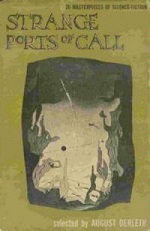 The story also appeared in August Derleth’s 1948 anthology, Strange Ports of Call. The story also appeared in August Derleth’s 1948 anthology, Strange Ports of Call.

| | “Far Centaurus”
by A.E. van Vogt
First publication: Astounding, Jan 1944

Four men set out for Alpha Centauri on a 500-year journey where each will awaken only a handful of times. That’s not time travel, of course, but be patient and you will run into real time travel.

Van Vogt combined this with two other stories and some fix-up material (especially for “Far Centaurus”) for his 1970 publication of Quest for the Future. We’re here! It’s over, the long night, the incredible journey. We’ll all be waking, seeing each other, as well as the civilization out there. Seeing, too, the great Centauri suns. We’re here! It’s over, the long night, the incredible journey. We’ll all be waking, seeing each other, as well as the civilization out there. Seeing, too, the great Centauri suns. 
| |
| | | | |

 
 | | | | 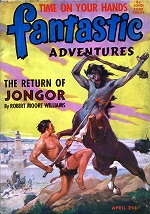

| | “Time on Your Hands”
by David Wright O’Brien (as by John York Cabot)
First publication: Fantasic Adventures, Apr 1944

Although I enjoyed the first Reggie Vliet story (“The Man Who Changed History’), this second story didn’t grab me, even though Reggie does inherit the time-travel watch and travels to see Antony and Cleopatra, Caesar, the sacking of Rome, and Columbus.

It does make me reflective to know that this story was written shortly before O’Brien’s death in a World War II bomber over Europe. He, Reggie Vliet, was again actually living in the past. He could enjoy it, relish it, admire it, and—change it. That was why he was here. To scramble the past, knock it off its customary track, blast it out of its timeworn groove. He, Reggie Vliet, was again actually living in the past. He could enjoy it, relish it, admire it, and—change it. That was why he was here. To scramble the past, knock it off its customary track, blast it out of its timeworn groove. 
| |
| | | | |

 
 | | | | 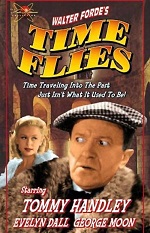

| | Time Flies
by Ted Kavanagh, J.O.C. Orton and Howard Irving Young (Walter Forde, director)
First release: 8 May 1944

Actress Susie Barton’s husband invested their nestegg in Time Ferry Services, Ltd., but the only way she’ll ever get anything out of it is by taking a trip to Elizabethan times. The Professor: Time? What is time? Having successfully controverted the classical views of Euclid and Newton, we arrive at the Theory of Relativity, which states that space-time in the neighborhood of a gravitational field is curved—pop!, pardon—whereas at an infinite distance from such a field field, it is not. The Professor: Time? What is time? Having successfully controverted the classical views of Euclid and Newton, we arrive at the Theory of Relativity, which states that space-time in the neighborhood of a gravitational field is curved—pop!, pardon—whereas at an infinite distance from such a field field, it is not.
Tommy: How true, how true! Proceed, Prof.
The Professor: Now, the curvature of space-time at any point in the continuum is proportional to the intensity of the gravitational field at that point, and consequently, as I have shown, there is no reason whatever why time should be of infinite duration.
Bill: Very interesting, isn’t it?
Susie: Yeah, what’s he talking about?
Bill: He didn’t say. 
| |
| | | | |

 | | | | 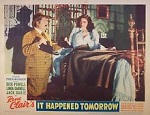

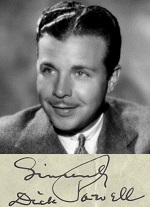

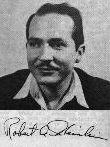

| | It Happened Tomorrow
by Dudley Nichols, René Clair(Clair, director)
First release: 28 May 1944

One day at the end of the 19th century, newspaperman Larry Stevens is given the gift of tomorrow’s newspaper by the ghost of the archive man, Pops Benson. That leads him to improve his position at the newspaper by scooping a story; but it also leads to trouble, more of tomorrow’s papers, and a romance with the alluring clairvoyant Sylvia.

So why do I count this as time travel when, for example, The Gap in the Curtain is not? The future newspapers in Gap never actually appear, and it felt as if they were mere visions of a possible future, whereas there’s no doubt that Larry holds the actual artifact in his hands. And besides, the movie had a great take on events may be fated and yet, when accompanied by charming misunderstandings, lead to the unexpected. (And as a bonus, movie star Dick Powell is the spitting image of Robert A. Heinlein of the time.)

According to the Authority on American Film, the original screenplay was bought by Frank Capra from Hugh Wedlock and Howard Snyder; Capra also bought the rights to a similar Lord Dunsany play, The Jest of Haha Laba, after which the rights were sold to producer Arnold Pressburger.

Early Edition, one of my favorite tv shows, uses the same idea of tomorrow’s paper, but its creators said that the show was not based on this movie. But I’m afraid I’m going to end up at the St. George Hotel at 6:25 no matter where I go. But I’m afraid I’m going to end up at the St. George Hotel at 6:25 no matter where I go. 
| |
| | | | |

 
No Time Travel. Move along. |
“The Yehudi Principle” by Fredric Brown, Astounding, May 1944 [predictions ]

| |     |